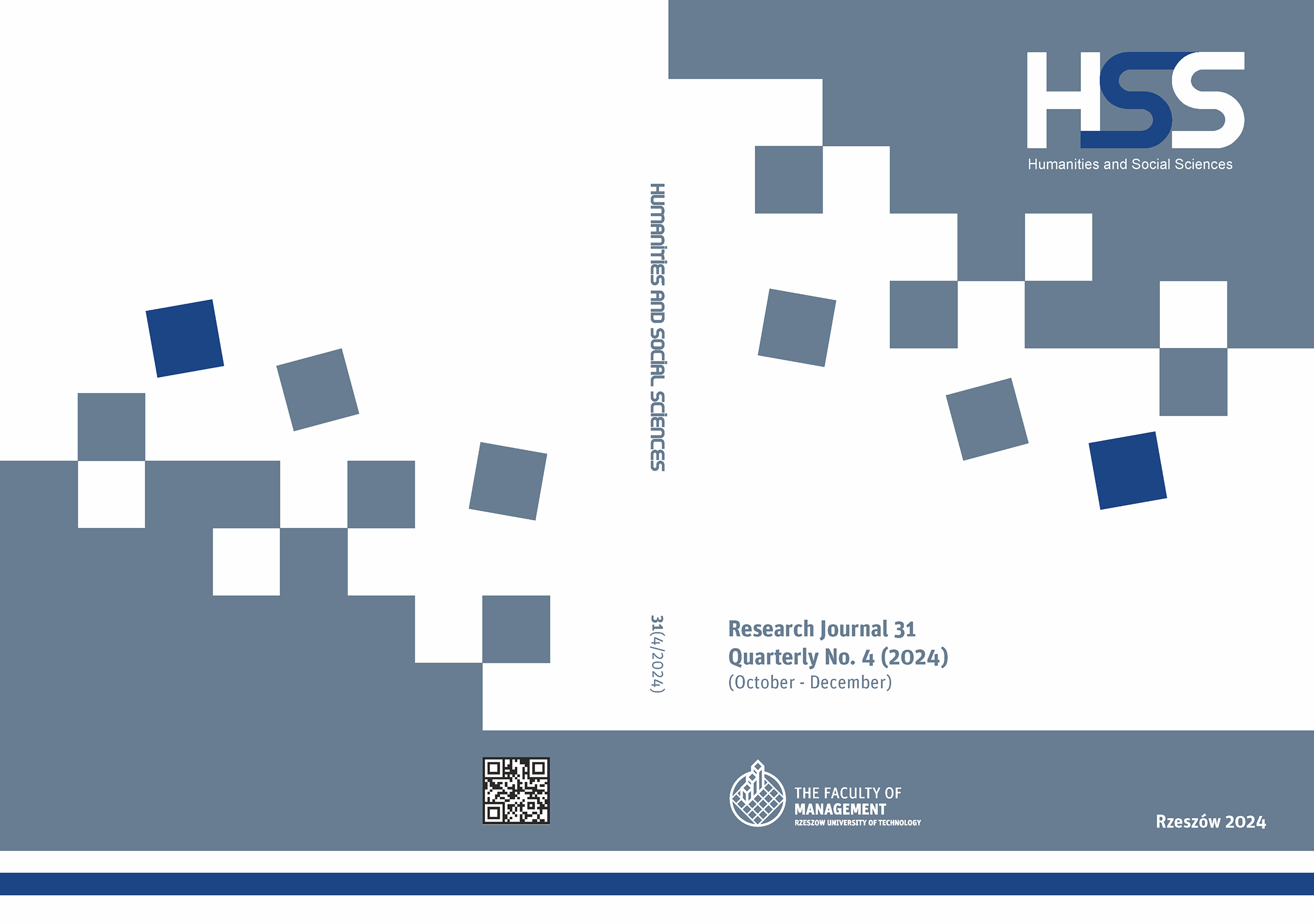Abstract
The paper explores the factors that impact a firm’s propensity to collaborate on innovation activities based on a questionnaire survey conducted with 104 innovation-active enterprises from Lubelskie Voivodeship, covering the years 2017-2019. The factor analysis was applied to categorize collaboration partners into institutional, market, and internal. To explain the enterprise’s propensity to collaborate on innovation, we employed two linear regression models. As determinants of cooperation, we included the absorptive capacity, the firm size, and the scale of activity. The results reveal that absorptive capacity, firm size, and scale of activity significantly enhance collaboration with institutional partners, while firm size has a greater impact on the propensity to collaborate with market partners among microenterprises compared to small enterprises. The findings underscore the role of innovation expenditures and firm-specific characteristics in shaping collaborative innovation behaviors, emphasizing the critical importance of partnerships for fostering innovation in enterprises.
References
Afifi, A.A., May, S., Donatello, R.A., Clark, V.A. (2020). Practical multivariate analysis (6th ed.). Boca Raton, FL: CRC Press.
Ali A., Ahmed S. (2022). Big data analytics and supply chain performance: The mediating role of supply chain capabilities and innovation. “Management Science Lettersc”, 12(4). DOI: 10.5267/j.msl.2022.4.003.
Archibugi, D., Coco, A. (2004). International partnerships for knowledge in business academia: A comparison between Europe and the US. “Technovation”, 24(7). DOI: 10.1016/S0166-4972(02)00102-6.
Belderbos, R., Gilsing, V., Lokshin, B., Carree, M., Sastre, J.F. (2018). The antecedents of new R&D collaborations with different partner types: On the dynamics of past R&D collaboration and innovative performance. “Long range planning”, 51(2). DOI: 10.1016/j.lrp.2017.10.002.
Barge-Gil, A. (2010). Cooperation-based innovators and peripheral cooperators: An empirical analysis of their characteristics and behavior. “Technovation”, 30(3). DOI: 10.1016/j.technovation.2009.11.004.
Becker, W., Dietz, J. (2004). R&D cooperation and innovation activities of firms – evidence for the German manufacturing industry. “Research Policy”, 33(2). DOI: 10.1016/j.respol.2003.07.003.
Blois, K. (1998). Don’t all firms have relationships? “Journal of Business & Industrial Marketing”, 13(3). DOI: 10.1108/08858629810222289.
Camisón, C., Villar, A. (2009). Capabilities and propensity for cooperative internationalization. “International Marketing Review”, 26(2). DOI: 10.1108/02651330910950394.
Carvalho, L., Madeira, M.J., Carvalho, J., Moura, D.C., Duarte, F.P. (2018). Cooperation for innovation in the European Union: outlook and evidences using CIS for 15 European countries. “Journal of the Knowledge Economy”, 9. DOI: 10.1007/s13132-018-0520-6.
Chen, Y., Vanhaverbeke, W., Du, J. (2016). The interaction between internal R&D and different types of external knowledge sourcing: An empirical study of Chinese innovative firms. “R&D Management”, 46(S3). DOI: 10.3846/tede.2018.5694.
Chesbrough, H. (2003). Open innovation: The new imperative for creating and profiting from technology. Harvard Business School Press.
Cohen, W.M., Levinthal, D.A. (1990). Absorptive capacity: A new perspective on learning and innovation. “Administrative science quarterly”, 35(1).
Dahlander, L., Gann, D.M., Wallin, M.W. (2021). How open is innovation? A retrospective and ideas forward. “Research Policy”, 50(4). DOI: 10.1016/j.respol.2021.104218.
D’Angelo, A., Ganotakis, P., Love, J.H. (2020). Learning by exporting under fast, short-term changes: The moderating role of absorptive capacity and foreign collaborative agreements. “International Business Review”, 29(3). DOI: 10.1016/j.ibusrev.2020.101687.
Faria, P. de, Lima, F., Santos, R. (2010). Cooperation in innovation activities: The importance of partners. “Research Policy”, 39(8). DOI: 10.1016/j.respol.2010.05.003.
Forsgren, M., Hägg, I., Håkansson, H., Johanson, J., Mattson, L.G. (1995). Firms in networks: A new perspective on competitive power. Uppsala University, Uppsala.
Håkansson, H., Johanson, J. (1992). A model of industrial networks [In:] Axelsson, B., Easton, G., eds., Industrial networks: A new view of reality (p. 28–34). Routledge.
Igna, I., Venturini, F. (2023). The determinants of AI innovation across European firms. “Research Policy”, 52(2). DOI: 10.1016/j.respol.2022.104661.
Lasagni, A. (2012). How can external relationships enhance innovation in SMEs? New evidence for Europe. “Journal of Small Business Management”, 50(2). DOI: 10.1111/j.1540-627X.2012.00355.x.
Matras-Bolibok, A. (2012). Efektywność współpracy przedsiębiorstw w zakresie działalności innowacyjnej. “Prace Naukowe Uniwersytetu Ekonomicznego we Wrocławiu”, 262.
Mazur, J. (2011). Współpraca przedsiębiorstw w teorii i praktyce polskiej. “International “Journal of Management and Economics”, 32.
Nieto, M.J., Santamaria, L. (2010). Technological collaboration: Bridging the innovation gap between small and large firms. “Journal of Small Business Management”, 48(1). DOI: 10.1111/j.1540-627X.2009.00286.x
Nieto, M.J., Santamaria, L., Fernandez, Z. (2015). Understanding the innovation behavior of family firms. “Journal of Small Business Management”, 53(2). DOI: 10.1111/jsbm.12075.
Perez-Alaniz, M., Lenihan, H., Doran, J., Hewitt-Dundas, N. (2022). Financial resources for research and innovation in small and larger firms: Is it a case of the more you have, the more you do? “Industry and Innovation”. DOI: 10.1080/13662716.2022.2036597.
Poznańska, K. (1998). Uwarunkowania innowacji w małych i średnich przedsiębiorstwach. Warszawa: Dom Wydawniczy ABC.
—— (2016). Współpraca małych i średnich przedsiębiorstw z podmiotami zewnętrznymi w zakresie innowacyjności. “Studia Ekonomiczne. Zeszyty Naukowe Uniwersytetu Ekonomicznego w Katowicach”, 280, 143–156.
Ritter, T., Ford, D. (2004). Interactions between suppliers and customers in business markets [In:] Håkansson, H., Harrison, D., Waluszewski, A., eds., Rethinking marketing: Developing a new understanding of markets (p. 99–115). John Wiley & Sons.
Rojek, D. (2017). Wewnętrzne czynniki innowacyjności przedsiębiorstw. “Zarządzanie. Teoria i Praktyka”, 21(3).
Stanisławski, R. (2014). Open innovation wśród małych i średnich przedsiębiorstw jako instrument kształtowania przewagi konkurencyjnej. “Economics and Management”, 2. DOI: 10.12846/j.em.2014.02.13.
Sudolska, A. (2011). Uwarunkowania budowania relacji proinnowacyjnych przez przedsiębiorstwa w Polsce. Toruń: Wydawnictwo Naukowe UMK.
Tiwari, A.K., Mohnen, P., Palm, F.C., van der Loeff, S.S. (2007). Financial constraints, capital structure and innovation: An empirical investigation. “UNU-MERIT Working Papers”, 011.
Wściubiak, Ł. (2019). Motywy współpracy międzyorganizacyjnej w działalności innowacyjnej – perspektywa przedsiębiorstw produkcyjnych w Polsce. “Przegląd Organizacji”, 8(955). DOI: 10.33141/po.2019.08.02.
Yu, G.J., Lee, J. (2017). When should a firm collaborate with research organizations for innovation performance? The moderating role of innovation orientation, size, and age. “The Journal of Technology Transfer”, 42(6). DOI: 10.1007/s10961-016-9469-4.
Van Beers, C., Zand, F. (2014). R&D cooperation, partner diversity, and innovation performance: an empirical analysis. “Journal of Product Innovation Management”, 31(2). DOI: 10.1111/jpim.12096.
Xie, X., Liu, X., Chen, J. (2023). A meta-analysis of the relationship between collaborative innovation and innovation performance: The role of formal and informal institutions. “Technovation”, 124. DOI: 10.1016/j.technovation.2023.102740.


